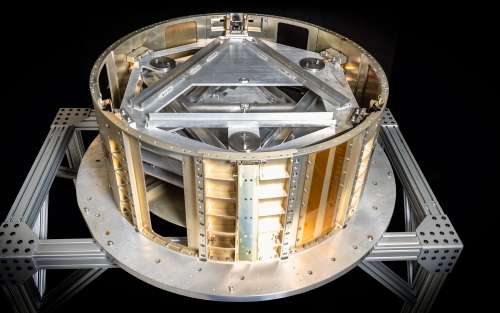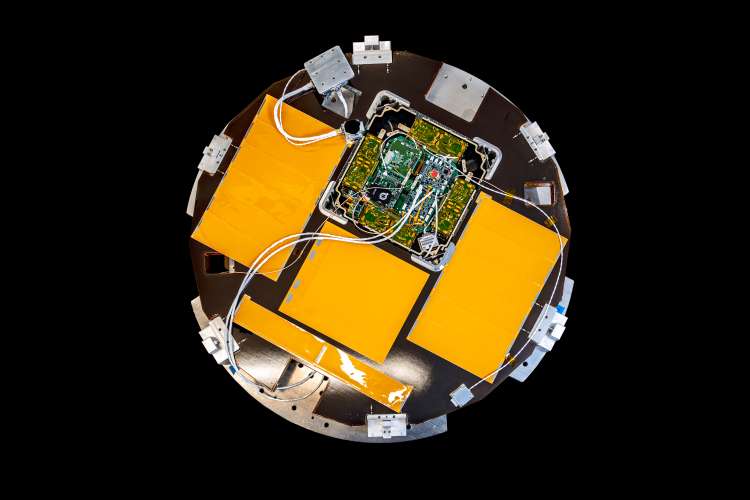The Aerospace Corporation’s DiskSat is approaching a major milestone, with its first spaceflight demonstration slated for launch toward the end of this year. This mission, supported by NASA’s Small Spacecraft and Distributed Systems program, will be a critical step in proving DiskSat’s viability as a scalable platform that can be widely adopted and adapted by partners across the space enterprise. The launch is provided through the DoD Space Test Program under the U.S. Space Force's Space Systems Command.
By fostering collaboration and knowledge-sharing, the DiskSat program aligns with Aerospace’s role as end-to-end connector, accelerating innovation across both government and commercial space sectors. The upcoming demonstration will validate the spacecraft’s capabilities while exploring how its low-cost, high-performance design can be leveraged for future missions, particularly in very low Earth orbit (vLEO).
The mission will deploy a constellation of four DiskSats to test the platform’s maneuverability, launch dispenser mechanism and orbit-changing capabilities using electric propulsion—key features in flexible, responsive space operations. With its flat, plate-shaped design—one meter in diameter and 2.5 centimeters thick—DiskSat is well-suited for rideshare launches and emerging orbital mission needs. Its lightweight and unique shape improves the power-to-mass ratio, and its material, shape and layout improve the potential for rapid manufacturing. Interest in utilizing DiskSat in synthetic aperture radar (SAR) applications has also been growing.

“DiskSat is an exciting shift in small satellite development,” said Catherine Venturini, principal engineer/scientist within the System Realization Subdivision. “This demonstration will not only validate our technical approach but also open new doors for commercialization and future missions in vLEO and beyond.”
Final platform development efforts are moving quickly, with flight units on track to be ready by this October.
The Potential for vLEO Operations
Interest in vLEO is growing rapidly, driven by both government and commercial space missions seeking to leverage the unique advantages of operating closer to Earth. Compared to traditional low Earth orbit (LEO) altitudes, which range from 500-1,200 kilometers, vLEO—typically 300-450 kilometers— offers several benefits:
- Sharper imaging and sensing capabilities due to closer proximity to Earth.
- Lower-latency communications, improving real-time data transmission.
- Reduced debris risk, as satellites in vLEO naturally deorbit faster, supporting space sustainability goals.

However, operating in vLEO comes with significant challenges, including increased atmospheric drag, which typically shortens mission lifetimes unless compensated by onboard propulsion. DiskSat’s flat shape and electric propulsion system are designed to address this, making the platform an ideal candidate for future missions in this region.
“The ability to operate efficiently in vLEO is a game-changer,” Venturini said.
The upcoming demo mission will provide valuable data on power efficiency, thermal performance and propulsion effectiveness in vLEO. These insights will directly inform the development of future small satellite architectures for longer-duration vLEO operations, opening new possibilities for commercial, civil and national security space applications.
Accelerating Innovation Through Commercialization
Beyond proving the satellite’s technical capabilities, DiskSat’s modular architecture, compact form factor and scalable design make it adaptable across multiple space sectors. The DiskSat dispenser system is another key unique innovation that improves scalability and integration flexibility for different payloads. It will be able to incorporate different designs and payloads, which is a big advantage for multi-mission use.
Government and commercial space and academia could leverage the DiskSat platform for a variety of missions including:
- On-orbit technology demonstrations for emerging space technologies.
- Earth observation and environmental monitoring at unprecedented resolution.
- Rapid constellation deployments, enabling flexible and cost-effective mission architectures.
- Space situational awareness, providing a responsive and maneuverable platform for tracking objects in space.
Additionally, there are ongoing discussions about the different licensing models for DiskSat. Some companies and agencies may be interested in manufacturing the satellite themselves, while others could focus on leveraging the platform for services.
“This demonstration is critical,” Venturini said. “We’re getting a lot of ‘wait and see’ interest. If everything goes well, we anticipate a major increase in industry engagement—expecting a lot of phone calls.”
Stay tuned for further updates as the launch window nears. With DiskSat, Aerospace is not just launching a novel new small satellite—it’s laying the groundwork for the future of responsive, scalable and transferable space technology.

